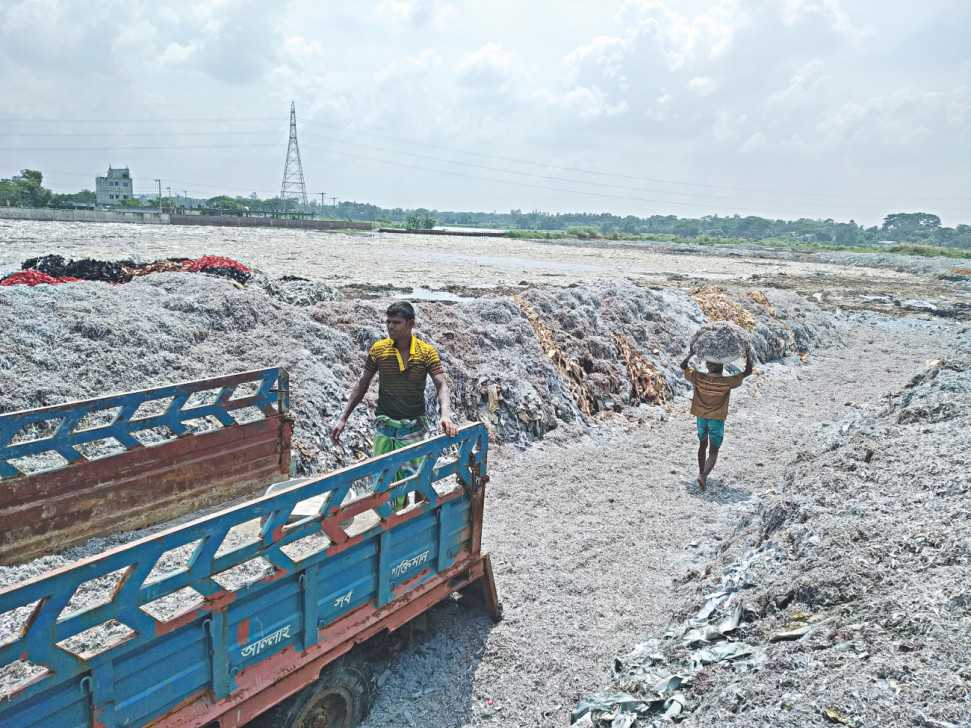Leather sector’s woes not ending soon

Image collected
Absence of a fully functional central effluent treatment plant (CETP) and solid waste management at Savar Tannery Industrial Estate has been costing Bangladesh’s leather and leather goods exporters heavily.
Currently, Bangladeshi exporters do not have any choice but to sell their goods at rates 30 percent lower than the global prices for non-compliance, industry insiders said.
Leather goods exporters do not get higher prices of their products unless the Leather Working Group (LWG), the global compliance audit organisation, certifies companies that they are compliant.
Since Bangladesh can’t comply with the conditions of the LWG, the local leather and leather goods exporters have to sell at much lower prices to buyers from China, who are not too fussed about compliance.
Among other factors, the issue of non-compliance by tanners and the tannery industry authority was responsible for the rawhide price crash last Eid-ul-Azha.
The tanners could not pay the rawhide merchants before Eid as they were still sitting on 50 percent of their old stock because of low demand from international buyers on the ground of non-compliance.
Major global compliant brands stopped buying leather and leather goods from Bangladesh a few years ago because of their environmental pollution. So the government has shifted the tanneries from Hazaribagh to Savar.
Earlier in 2012, the government had floated a tender for construction of a CETP and a Chinese company that won the bidding started the works in 2014 for completion by 2017.
But the job is not done yet.
The delay was because of a dispute between the Chinese company and local contractors, said Jitendra Nath Paul, project director of the Savar Tannery Industrial Estate.
Because of the dispute construction work was on pause for two years. So far, more than Tk 700 crore has been spent to complete the CETP, which includes the purchase of land at Tk 200 crore. “Our target is to complete the construction of the CETP by December this year as we are fixing some parts for its automation,” said Delwar Hossain, team leader of the CETP.
He, however, said the construction of the waste management yard will take more time as the tannery estate authority has been developing three such yards on 1,200 square feet, 30,000 square feet and 28,000 square feet.
The construction of the yards may be completed in March next year.
“If the construction of the yards can be completed properly, I am hopeful that the LWG will be satisfied, although a power plant was supposed to be set up to produce electricity by burning the sludge and other wastes in the estate.”
The tannery estate can’t set up a sludge-burn power plant at the estate because a Chinese company failed provide an acceptable design for it, said Hossain, also a teacher of the civil engineering department of the Bangladesh University of Engineering and Technology (BUET).
The LWG gives certification after racking up 1,365 points.
Of the total points, the tannery factory owners will have to obtain 900, the CETP 100 and the authorities 100. The remaining points will be given on other factors, he said.
In the absence of permanent yards, the tanneries have been dumping waste and sludge on a temporary dumping ground on six acres of land inside of the estate.
“The temporary dumping ground is also polluting the environment,” Hossain added.
The tanners also need to lower water consumption to get the LWG certification, Paul said.
Currently, the factories consume 66 tonnes of water to tan a tonne of rawhide, whereas the international standard is 25 tonnes.
It will take a lot of years to meet LWG’s conditions as the tanners are working on construction of the factories and invested money on land purchase and machinery, said Md Shaheen Ahmed, chairman of the Bangladesh Tanners Association.
Bangladesh produces nearly 400 million square feet of rawhide, of which the local leather and footwear companies consume 30 million square feet.
Some leather goods and footwear companies import 20 lakh square feet high-quality leather to make exportable goods, according to industry insiders.
Source: https://www.thedailystar.net
Previous Story
- FDI in apparel, textile industries
- ‘Manufacturing feeling the heat of trade war’
- 400 Bangladesh’s garment factories barred from accepting Western...
- China wants trade talks but if US wants...
- A front-runner in bike industry
- Bangladesh can reap benefit from US-China trade war
- Apple Mac Pro tariff relief denied by Trump
- Put national interest above everything